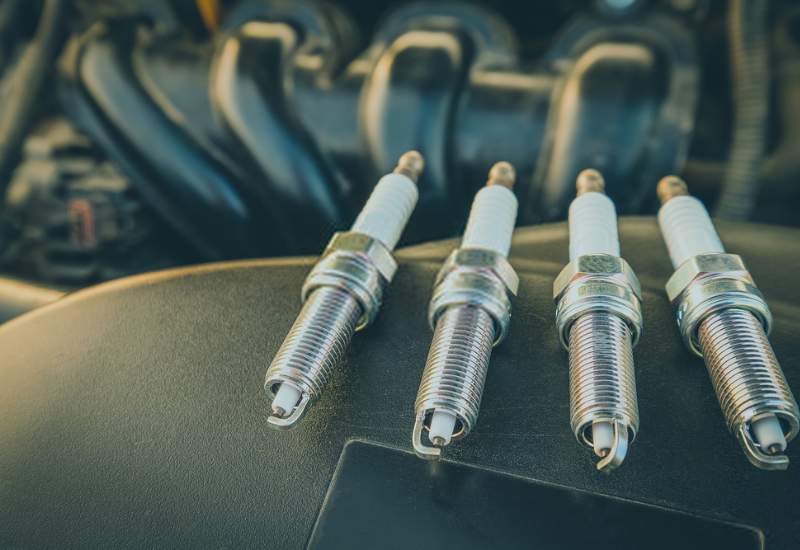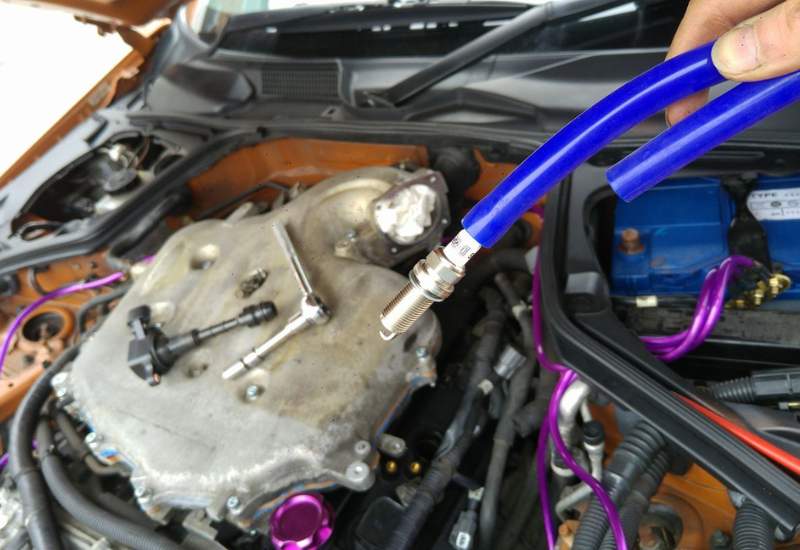How to Change Spark Plugs: A Comprehensive Guide for DIY Car Maintenance
Spark plugs, the unsung heroes of your car's engine, play a crucial role in delivering the spark that ignites the fuel-air mixture, propelling your vehicle forward. These small yet indispensable components work tirelessly, ensuring smooth operation and optimal performance. However, like any hardworking part, spark plugs eventually wear out, becoming less efficient and leading to a host of problems, including misfires, reduced fuel economy, and even engine damage.
If you're experiencing these issues or simply want to keep your car in top condition, changing your spark plugs is an essential maintenance task that can be easily accomplished with a bit of know-how and the right tools. This comprehensive guide will walk you through the process of changing spark plugs like a pro, empowering you to save money on mechanic visits and ensure your car continues to purr like a kitten.

Why Change Spark Plugs?
Spark plugs are subjected to intense heat, pressure, and electrical currents during engine operation, causing them to wear out over time. When spark plugs become worn or damaged, they can no longer effectively ignite the fuel-air mixture, leading to a range of problems:
-
Misfires: Misfires occur when the fuel-air mixture in one or more cylinders fails to ignite, causing a shuddering or jerking sensation while driving.
-
Reduced Fuel Economy: Inefficient spark plugs can lead to incomplete combustion, resulting in wasted fuel and reduced fuel economy.
-
Engine Damage: In severe cases, worn or damaged spark plugs can cause engine damage due to excessive heat and pressure.
Benefits of Changing Spark Plugs
Replacing worn spark plugs with new ones offers a multitude of benefits:
-
Improved Engine Performance: New spark plugs ensure optimal ignition, leading to smoother acceleration, better throttle response, and more power.
-
Enhanced Fuel Economy: Efficient spark plugs promote complete combustion, maximizing fuel efficiency and reducing fuel costs.
-
Reduced Emissions: Properly functioning spark plugs help lower emissions, contributing to a cleaner environment.
-
Extended Engine Lifespan: By maintaining your spark plugs, you can prevent engine damage and prolong the life of your car.
Cost-Effectiveness of DIY Spark Plug Replacement
Changing spark plugs is a relatively simple and cost-effective DIY task compared to paying a mechanic. The cost of spark plugs varies depending on the car's make and model, but typically ranges from AED 100 to AED 500 for a set of four. With a basic set of tools and a bit of mechanical aptitude, you can save money on labor costs and gain a sense of accomplishment by performing this maintenance yourself.
Importance of Proper Spark Plug Selection
Using the correct spark plugs for your specific car is crucial for optimal engine performance and longevity. Different engines require different spark plug specifications, such as heat range, thread size, and electrode material. Consult your car's owner's manual or consult a trusted auto parts store to ensure you select the right spark plugs for your vehicle.
What You'll Need
Before you begin, gather the following tools and materials:
Essential Tools
-
Spark plug socket and ratchet: A spark plug socket fits snugly around the spark plug and provides a secure grip for removal and installation. A ratchet provides the leverage needed to loosen and tighten the spark plugs.
-
Spark plug gap gauge: A spark plug gap gauge is a specialized tool used to measure the gap between the center electrode and the ground electrode of the spark plugs. This gap is crucial for proper spark ignition.
-
Torque wrench: A torque wrench ensures that the spark plugs are tightened to the manufacturer's specified torque. Overtightening can damage the spark plugs or the engine components, while undertightening can cause leaks or misfires.
-
Dielectric grease: Dielectric grease is a non-conductive lubricant that helps prevent corrosion and ensures smooth removal of spark plugs during future maintenance.
Additional Materials
-
Compressed air or shop vacuum: Compressed air or a shop vacuum is useful for cleaning the spark plug wells and removing any debris that could fall into the engine cylinders.
-
New spark plugs (compatible with your car's make and model): Choose the correct spark plugs for your specific car's engine. Refer to your owner's manual or consult an auto parts store for the recommended spark plug type.
-
Clean rags or towels: Clean rags or towels are handy for wiping up any dirt or spills during the process.
Optional Tools
-
Flashlight: A flashlight can help illuminate the spark plug wells and provide better visibility when working in tight spaces.
-
Needle-nose pliers: Needle-nose pliers can be helpful for removing any stubborn spark plug wires or ignition coils.
-
Spark plug boot puller: A spark plug boot puller is a specialized tool designed to remove spark plug wires without damaging the boots.
-
Anti-seize lubricant: Anti-seize lubricant can be applied to the threads of the new spark plugs to prevent corrosion and ensure easier removal in the future.
Safety Gear
-
Safety glasses: Safety glasses protect your eyes from flying debris or sparks during the spark plug removal process.
-
Gloves: Gloves protect your hands from hot engine parts, grease, and dirt.
-
Hearing protection: Hearing protection, such as earplugs or earmuffs, is recommended if you are using compressed air or a shop vacuum.
Additional Tips
-
Work on a cool engine: Allow the engine to cool completely before attempting to remove the spark plugs. Hot spark plugs can be difficult to handle and pose a burn risk.
-
Label the spark plug wires: If you have spark plug wires, label them before disconnecting them to ensure correct reinstallation.
-
Remove one spark plug at a time: Working on one cylinder at a time prevents debris from falling into multiple cylinders.
-
Inspect the spark plug wells for damage: Check the spark plug wells for cracks or damage that could cause leaks or engine issues.
-
Torque spark plugs to the manufacturer's specifications: Overtightening or undertightening spark plugs can lead to problems. Use a torque wrench to ensure proper torque.
-
Dispose of old spark plugs responsibly: Do not throw away old spark plugs in the trash. Take them to an auto parts store or recycling center for proper disposal.
Safety Precautions
-
Work on a level surface and engage the parking brake: Choose a flat, stable surface to park your car on and engage the parking brake to prevent it from rolling while you're working.
-
Allow the engine to cool completely: Never attempt to change spark plugs on a hot engine. Hot engine components can cause severe burns.
-
Disconnect the negative battery terminal: Before touching any electrical components, disconnect the negative battery terminal to prevent accidental electrical shorts.
-
Wear safety glasses and gloves: Protect your eyes from flying debris or sparks by wearing safety glasses. Use gloves to shield your hands from hot engine parts, grease, and dirt.
-
Work in a well-ventilated area: Avoid inhaling harmful fumes by working in a well-ventilated garage or open area.
-
Use compressed air or a shop vacuum carefully: When cleaning the spark plug wells with compressed air or a shop vacuum, ensure proper ventilation to avoid inhaling debris.
-
Avoid touching hot engine parts: Be cautious around hot engine components, including the exhaust manifold, spark plugs, and cylinder head.
-
Inspect spark plugs for damage: Examine the old spark plugs for signs of wear, damage, or excessive deposits. If you notice any abnormalities, consult a mechanic to check for underlying engine issues.
-
Follow torque specifications: Use a torque wrench to tighten the new spark plugs to the manufacturer's specified torque. Overtightening or undertightening can lead to problems.
-
Dispose of old spark plugs responsibly: Do not throw away old spark plugs in the regular trash. Take them to an auto parts store or recycling center for proper disposal.
By adhering to these safety precautions, you can minimize risks and ensure a safe and successful spark plug replacement experience. Remember to prioritize safety throughout the process and seek professional assistance if you have any doubts or concerns.

Step-by-Step Guide to Changing Spark Plugs
Preparation
-
Gather the necessary tools and materials: Ensure you have all the tools and materials listed in the "What You'll Need" section.
-
Park your car on a level surface and engage the parking brake: This will prevent the car from rolling while you are working on it.
-
Allow the engine to cool completely: As mentioned earlier, work on a cool engine to avoid burns.
-
Disconnect the negative battery terminal: This will prevent accidental electrical shorts while working on the ignition system.
Removing the Old Spark Plugs
-
Locate the spark plugs: Refer to your car's owner's manual or repair guide to identify the locations of the spark plugs. They are typically found on top of the engine, screwed into the cylinder head.
-
Remove the ignition coils or spark plug wires: If your car has ignition coils, use the appropriate socket or wrench to disconnect them from the spark plugs. If you have spark plug wires, pull them off the spark plugs gently.
-
Clean the spark plug wells: Use compressed air or a shop vacuum to remove any dirt or debris from the spark plug wells. This will prevent debris from falling into the engine cylinders.
-
Remove the old spark plugs: Attach the spark plug socket to the ratchet and carefully loosen each spark plug, turning it counterclockwise. Once loose, remove the spark plug by hand.
-
Inspect the old spark plugs: Examine the old spark plugs for signs of wear or damage. Worn or damaged spark plugs may indicate underlying engine issues that require mechanic attention.
Installing the New Spark Plugs
-
Gap the new spark plugs: Use a spark plug gap gauge to check the gap between the center electrode and the ground electrode of the new spark plugs. Adjust the gap if necessary, bending the ground electrode slightly.
-
Apply dielectric grease: Apply a thin layer of dielectric grease to the threads of the new spark plugs. This helps prevent corrosion and ensures smooth removal during future maintenance.
-
Install the new spark plugs: Carefully screw the new spark plugs into the spark plug wells by hand, turning them clockwise. Once finger tight, use the torque wrench to tighten them to the manufacturer's specified torque.
-
Reconnect ignition coils or spark plug wires: Reconnect the ignition coils or spark plug wires to the corresponding spark plugs, ensuring a secure fit.
-
Reconnect the negative battery terminal: Reconnect the negative battery terminal to restore electrical power to the car.
Testing and Final Checks
-
Start the engine: Start the engine and check for any warning lights or unusual noises. If everything appears normal, take your car for a test drive to ensure smooth operation.
-
Check for leaks: After the test drive, inspect the spark plug wells for any signs of oil or coolant leaks.
-
Dispose of old spark plugs responsibly: Do not throw away old spark plugs in the trash. Take them to an auto parts store or recycling center for proper disposal.
Additional Tips
-
Work in a well-ventilated area: Avoid inhaling harmful fumes by working in a well-ventilated area.
-
Take your time and be careful: Don't rush the process. Take your time and be careful to avoid damaging the spark plugs, spark plug wells, or engine components.
-
Consult your car's owner's manual: Refer to your car's owner's manual for specific instructions and torque specifications related to spark plug replacement.
-
Seek professional help if needed: If you encounter any difficulties or suspect underlying engine issues, don't hesitate to consult a qualified mechanic for assistance.
Frequently Asked Questions (FAQs)
How often should I change my spark plugs?
The frequency of spark plug replacement depends on your car's make, model, and driving habits. However, a general guideline is to change spark plugs every 30,000 to 60,000 miles. If you notice any signs of spark plug malfunction, such as misfires, reduced fuel economy, or rough idling, consider replacing them sooner.
What are the symptoms of bad spark plugs?
Here are some common symptoms that may indicate worn or damaged spark plugs:
-
Misfires: Misfires occur when one or more cylinders fail to fire properly, causing a shuddering or jerking sensation while driving.
-
Reduced fuel economy: Inefficient spark plugs can lead to incomplete combustion, resulting in wasted fuel and reduced fuel economy.
-
Rough idling: The engine may shake or vibrate excessively when idling due to misfires or incomplete combustion caused by worn spark plugs.
-
Hard starting: Difficulty starting the engine can be a symptom of worn spark plugs, which may not provide the necessary spark to ignite the fuel-air mixture effectively.
-
Engine check light illumination: In some cases, a malfunctioning spark plug can trigger the engine check light, indicating an issue with the ignition system.
Can I change spark plugs myself?
Yes, changing spark plugs is a relatively straightforward DIY task that can be accomplished with basic tools and mechanical aptitude. However, if you are not comfortable working on your car or lack the necessary tools, it is advisable to seek professional assistance from a qualified mechanic.
What type of spark plugs should I use for my car?
It is crucial to use the correct spark plugs for your specific car's engine. Different engines require different spark plug specifications, such as heat range, thread size, and electrode material. Consult your car's owner's manual or consult a trusted auto parts store to ensure you select the right spark plugs for your vehicle.
Can I use dielectric grease instead of anti-seize lubricant?
While both dielectric grease and anti-seize lubricant can help prevent corrosion and ensure smooth removal of spark plugs during future maintenance, they serve different purposes. Dielectric grease is specifically designed for electrical components and helps prevent electrical shorts, while anti-seize lubricant is a general-purpose lubricant that can be used on various metal parts. For spark plugs, it's recommended to use dielectric grease to protect the electrical integrity of the ignition system.
Changing spark plugs is an essential maintenance task that contributes to optimal engine performance, fuel economy, and overall vehicle longevity. By following the step-by-step guide and adhering to the safety precautions outlined in this comprehensive guide, you can empower yourself to perform this DIY task with confidence and save money on mechanic visits.
Remember to prioritize safety throughout the process, use the appropriate tools and techniques, and consult your car's owner's manual for specific instructions and torque specifications. With a bit of mechanical aptitude and the right guidance, you can keep your car's spark plugs in top condition, ensuring a smooth, efficient, and enjoyable driving experience.
Have a question for your car expert?
Click below for WhatsApp asking in under a minute.





